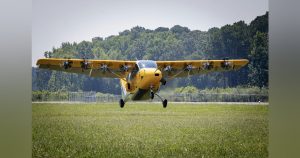FAA Calls for Industry Partnership on Revolutionary Air Traffic Control (ATC) System by 2028
Big changes are coming to U.S. airspace. The Federal Aviation Administration (FAA) is reaching out to industry experts to help develop a new, state-of-the-art Air Traffic Control (ATC) system that will address the evolving demands of the 21st century. This ambitious project aims to introduce a safer, more intelligent, and efficient system by the end of 2028. It represents a significant investment in the country’s airspace management, covering everything from traditional piloted flights to emerging drone technology and urban air mobility.
Importance of Upgrading the ATC System
The necessity for a modern ATC system has never been more pressing. The existing infrastructure in the U.S. is outdated, largely based on technologies from the Cold War era, including legacy radars and Time Division Multiplexing (TDM) technology. The current system faces various challenges, such as:
- Increased Air Traffic: The number of commercial flights is recovering to pre-COVID levels and beyond.
- Emerging Airspace Users: Drones, air taxis, commercial rockets, and uncrewed systems are changing airspace demands significantly.
- Safety Concerns: Events like the collision near Reagan National Airport highlight the urgent need for enhanced safety measures and system resilience.
Acting FAA Administrator Chris Rocheleau described this transition as a “once-in-a-generation opportunity” to establish a premier air traffic system, seeking global innovators to contribute their expertise.
FAA’s Vision for the Future ATC System
Core Areas of Focus
The FAA’s plan emphasizes four primary pillars:
- Communications: The transition to high-speed networks with internet protocol (IP) aims to replace outdated TDM systems, ensuring modern communication between pilots and controllers.
- Surveillance: Advancements in radar, along with cutting-edge ground and airborne sensors, will ensure real-time tracking of airspace users.
- Automation: New software and automation tools will enhance efficiency and aid in predictive management and conflict resolution.
- Facilities: Creation of six innovative Air Traffic Control Centers and improvements in towers, TRACONs, and weather data coverage, especially focusing on areas like Alaska.
Key Technical and Operational Enhancements
Substantial upgrades are planned, including:
- Telecommunications: Upgrades across over 4,600 FAA sites to enable nationwide high-speed connectivity.
- Surveillance Enhancements: Replacement of aging radars with advanced ground sensors to avoid runway incidents.
- Advanced Automation: A unified software platform to reduce system outages and maintenance.
- Weather Data: Introduction of 174 new weather stations to tackle operational challenges in difficult regions.
Industry’s Role in Shaping the System
Collaborative Partnership Models
The FAA is interested in industry proposals concerning various aspects of the system, prompting innovation in technical, business models, and cost strategies. Three partnership models have been outlined:
| Model Type | Description |
|---|---|
| Prime Integrator | Industry manages all new contracts, retiring old ones, and leads system integration. |
| Non-Prime Integrator | The FAA holds contracts; industry manages and oversees them. |
| Hybrid Integrator | Mixed management of contracts between the FAA and industry partners. |
Key processes include Industry Day discussions and a swift evaluation and contracting process due to modernization demands.
Opportunities and Challenges
The Potential Benefits
- Fewer Delays: Enhanced hardware and network resilience promise more reliable schedules for airlines.
- Increased Capacity: Ready for growth in sectors like commercial space, drones, and urban air transportation.
- Safety Improvements: Advanced technologies will prevent collisions and improve overall safety.
- Environmental Advantages: Optimized traffic flows could reduce emissions.
- Business Ecosystem: Opportunities for firms from aerospace to tech industries.
Challenges
- Funding: Estimated costs are $12.5 billion, with additional funding needed to avoid project delays.
- Complex Coordination: The vast geographic coverage requires integration with existing technologies.
- Cybersecurity: New security measures need to accompany the transition to IP-based networks.
- Regulatory Compliance: Staying aligned with FAA standards and international aviation rules is crucial.
Impact on Travelers and Industry
Passengers can expect smoother travel with fewer interruptions. Pilots and controllers will benefit from improved tools and reduced workloads. Drones, air taxis, and commercial space vehicles will find a system designed for seamless integration, making such routines feasible in busy airspace.
Business Landscape Transformation
This transformation offers opportunities for leading aerospace, tech companies, and construction and engineering firms, presenting a chance to define global aviation standards for the future. The effects will extend to regional airports, the tech industry, and emerging markets like drone delivery.
Why This Is Different from NextGen
Previous modernization efforts like “NextGen” faced criticism over extended timelines. The current initiative is concise, driven by industry expertise, and aims for a fast-paced rollout between 2025 and 2028.
Human Impact
This upgrade is ultimately about harnessing technology to empower people—from air traffic controllers managing flights in adverse conditions to drone pilots delivering medical samples across urban areas. The FAA’s openness to innovative ideas and its swift timelines cater to real safety needs and future airspace demands.
Conclusion: A Pivotal Moment for Aviation
The FAA’s initiative signals a bold leap towards the future, blending traditional expertise with innovations from tech and aerospace. Transportation Secretary Sean Duffy aptly stated, “We have a system built for the past, we are proposing a system built for the future.” This effort over the next three years will redefine how we navigate the skies, offering exciting prospects for industry leaders and travelers alike.













